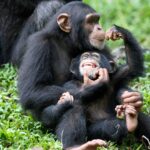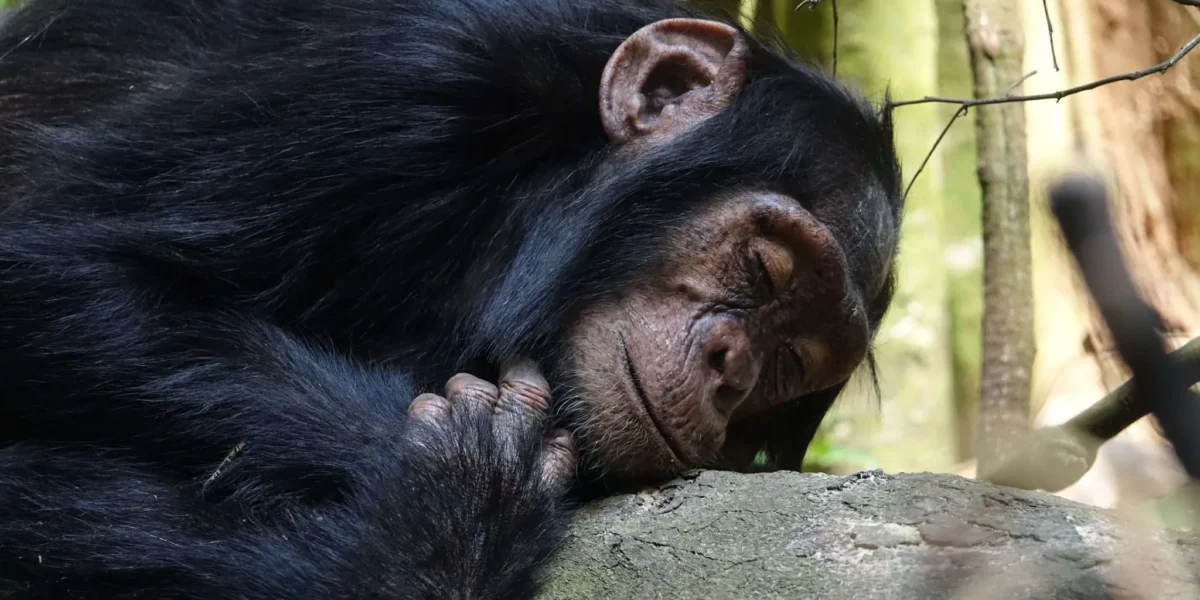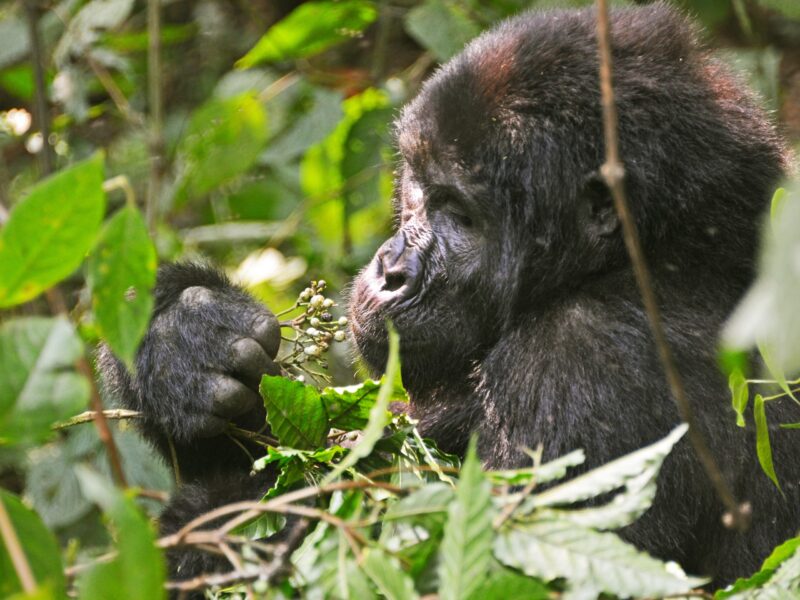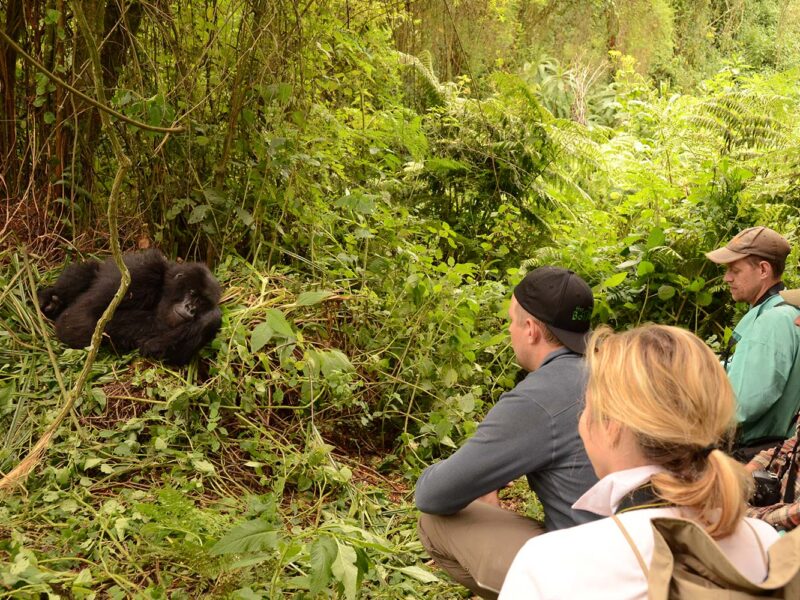Namibia Uganda Safari – The Ultimate African Wildlife and Cultural Adventure
October 15, 2025
Which Park is Best for Chimpanzee Tracking in Tanzania?
October 16, 2025How Does Chimpanzee Tracking Differ from Gorilla Trekking
How does chimpanzee tracking differ from gorilla trekking? This is one of the most common questions travelers ask when planning Uganda Safaris. Both experiences offer rare encounters with primates in their natural habitats, but each presents a unique story, distinct challenges, and unforgettable memories. At Winton Africa Safaris, we pride ourselves on delivering exceptional, educational, and transformative journeys through Africa’s primate territories.
Uganda, often called the “Pearl of Africa,” is home to half of the world’s remaining mountain gorillas and some of the largest populations of wild chimpanzees in East Africa. These two great apes represent the pinnacle of Uganda Gorilla Safaris and Uganda Chimpanzee Safaris, drawing nature enthusiasts, photographers, and conservationists from all over the world.
Introduction: Understanding Uganda’s Primate Adventures
But how exactly do Uganda Gorilla Trekking Safaris differ from Uganda Chimpanzee Safaris? The answer lies in several fascinating aspects — from their habitats, behaviors, and physical characteristics to the level of adventure, location, and overall safari experience. In this detailed guide, Winton Africa Safaris breaks down every difference to help travelers make informed choices and even combine both experiences into one life-changing journey through Uganda Best Safaris.
By understanding these distinctions, you not only deepen your appreciation of Uganda’s wildlife but also contribute to sustainable tourism that protects the country’s natural heritage and supports local communities through Uganda Cultural Safaris and conservation partnerships.
Habitats and Destinations: Where Do Chimpanzee Tracking and Gorilla Trekking Take Place?
To answer the question, how does chimpanzee tracking differ from gorilla trekking, it’s essential to begin with where these incredible adventures take place. Both gorillas and chimpanzees inhabit Uganda’s lush forests, but they live in distinctly different ecosystems, each offering a unique safari experience.
Uganda Gorilla Trekking Safaris primarily take place in Bwindi Impenetrable National Park and Mgahinga Gorilla National Park, located in southwestern Uganda. Bwindi’s misty rainforest is a UNESCO World Heritage Site and home to nearly half of the world’s endangered mountain gorillas. Trekking through this dense, ancient forest feels like stepping into a lost world, where every rustle and sound heightens your anticipation until you finally encounter a gorilla family resting, feeding, or nurturing their young.
In contrast, Uganda Chimpanzee Safaris are centered in Kibale National Park, known as the “Primate Capital of the World.” The park shelters over 1,500 chimpanzees alongside other primates such as red colobus monkeys and L’Hoest’s monkeys. Additional chimpanzee tracking destinations include Budongo Forest in Murchison Falls National Park, Kyambura Gorge in Queen Elizabeth National Park, and Toro-Semliki Wildlife Reserve.
So, how does the location difference affect your safari? Uganda Gorilla Safaris often involve trekking in steep, mountainous terrain, while Uganda Chimpanzee Safaris take place in flatter, more open forests. This means chimpanzee tracking tends to be faster-paced and filled with movement as chimps swing through the trees, while gorilla trekking offers slower, more intimate encounters.
Both settings, however, can be combined in one itinerary by Winton Africa Safaris, allowing travelers to experience both species while exploring Uganda’s biodiversity, from montane rainforests to lowland jungles — a true highlight of Uganda Best Safaris.
Behavior and Social Differences: Understanding Their World
How does chimpanzee tracking differ from gorilla trekking when it comes to behavior and social interaction? The difference is profound and fascinating.
Gorillas are gentle giants, living in cohesive family groups known as troops or bands, usually led by a dominant silverback male. During Uganda Gorilla Trekking Safaris, visitors are often amazed by the gorillas’ calm nature, their slow movements, and the strong social bonds within their families. You’ll see mothers nursing their young, juveniles playing, and the silverback maintaining order — a silent, majestic world of peace and power.
Chimpanzees, on the other hand, are dynamic, vocal, and incredibly expressive. During Uganda Chimpanzee Safaris, you’ll hear their loud pant-hoots and see them move swiftly from branch to branch. They live in larger, more complex communities that can include up to 100 individuals, and they exhibit sophisticated social behavior, cooperation, and even conflict. Unlike gorillas, who are more predictable, chimpanzees are spontaneous — making every tracking experience different and thrilling.
So, how does chimpanzee tracking differ from gorilla trekking behaviorally? The main distinction lies in the level of activity and unpredictability. Gorilla trekking is serene and meditative, while chimpanzee tracking is lively and energetic. Both experiences, however, reveal the deep intelligence and emotion of our closest relatives, reminding travelers of the delicate link between humans and nature.
For families or nature enthusiasts, Winton Africa Safaris can design a Uganda Wildlife Safari that includes both gorilla and chimpanzee encounters, offering insight into these species’ fascinating behaviors. Such combined safaris stand as a hallmark of Uganda Best Safaris and an unforgettable part of Touring Africa.
The Tracking Experience: What to Expect in Each Adventure
Another major difference in how chimpanzee tracking differs from gorilla trekking lies in the actual experience. Both are guided by professional rangers under the Uganda Wildlife Authority (UWA), but the duration, difficulty, and pace vary significantly.
Gorilla trekking often requires long hikes through thick vegetation, steep slopes, and sometimes muddy trails in high-altitude forests. The trek can last anywhere from 1 to 6 hours, depending on the gorillas’ location. Once a gorilla family is located, visitors spend one magical hour in their presence, observing them from a safe distance. Because gorillas are ground dwellers, sightings are typically close and calm, offering exceptional photography opportunities and emotional encounters.
Chimpanzee tracking, on the other hand, is more fast-paced. Chimps are constantly on the move, often high in the forest canopy, so visitors must follow their calls and movements quickly. The trek usually lasts between 2 to 4 hours, with one hour allowed for observation once the chimps are located. The experience is full of excitement, laughter, and curiosity as you watch them grooming, feeding, and communicating with loud vocalizations.
For travelers comparing both experiences, the question how does chimpanzee tracking differ from gorilla trekking is answered by your sense of adventure. Gorilla trekking offers tranquility and intimacy, while chimpanzee tracking delivers energy and unpredictability. Many visitors choose to do both, creating a balance of serenity and thrill within their Uganda Safaris.
At Winton Africa Safaris, we specialize in combining these experiences into one seamless journey, ensuring travelers experience the full spectrum of Uganda’s primate magic — all while enjoying safe, ethical, and sustainable tourism.
Permits, Cost, and Accessibility: What Are the Key Differences?
How does chimpanzee tracking differ from gorilla trekking when it comes to permits and accessibility? This is a crucial factor when planning your Uganda Gorilla Safaris or Uganda Chimpanzee Safaris with Winton Africa Safaris.
Gorilla trekking permits are more limited and therefore more expensive. As of recent Uganda Wildlife Authority guidelines, a gorilla trekking permit costs USD 800 per person per trek for foreign non-residents. This high cost directly supports conservation efforts and local community development around Bwindi and Mgahinga National Parks. Gorilla trekking is also more restricted — only eight visitors per gorilla family per day are allowed, ensuring minimal human impact on the animals.
Chimpanzee tracking permits are generally more affordable, ranging from USD 50 to USD 250 per person, depending on the location. Kibale National Park offers both standard tracking and a special Chimpanzee Habituation Experience, where visitors can spend a full day with researchers observing chimp behavior. This affordability and flexibility make chimpanzee tracking more accessible for larger groups or families on Uganda Wildlife Safaris.
Accessibility also differs. Bwindi’s mountainous terrain requires longer travel times and more effort to reach, whereas Kibale and Budongo are more centrally located and easily integrated into broader Uganda Best Safaris itineraries.
At Winton Africa Safaris, we help guests plan their budgets effectively, balancing adventure with comfort and conservation. Whether your priority is gorilla trekking, chimpanzee tracking, or both, we ensure that every permit, transfer, and lodge selection aligns with your travel goals.
Cultural and Educational Connections: Beyond the Forests
While discussing how chimpanzee tracking differs from gorilla trekking, it’s equally important to explore the cultural and educational dimensions tied to each experience.
Uganda Cultural Safaris add depth to every primate adventure. Around Bwindi, travelers can engage with the Batwa Pygmy Community, who share stories of their ancestral life in the forest before it became a national park. Their songs, dances, and storytelling sessions teach visitors about coexistence with wildlife and the importance of conservation.
Around Kibale, visitors can explore the Bigodi Community Wetland Project, a local initiative supporting ecotourism and birding. This area is also ideal for Uganda Birding Safaris, where families can spot over 200 bird species, including the Great Blue Turaco and African Pitta.
Cultural experiences make Uganda Safaris not just about wildlife, but about human connection and education. Winton Africa Safaris encourages travelers to blend Uganda Gorilla Trekking Safaris with cultural visits and Uganda Chimpanzee Safaris for a holistic experience. The combination of wildlife adventure and community engagement builds empathy and fosters sustainable tourism — values that define our brand’s commitment to responsible travel across Africa.
Combining Gorilla and Chimpanzee Experiences in One Safari
Many travelers ask if it’s possible to combine gorilla trekking and chimpanzee tracking in one safari itinerary. At Winton Africa Safaris, the answer is absolutely yes. Uganda’s compact geography allows easy travel between gorilla habitats in Bwindi and chimpanzee forests in Kibale or Budongo, making this combination one of the most rewarding wildlife journeys in East Africa.
A typical itinerary might begin with Uganda Chimpanzee Safaris in Kibale National Park, followed by Uganda Wildlife Safaris in Queen Elizabeth National Park, where you can see elephants, lions, and hippos, before concluding with Uganda Gorilla Safaris in Bwindi Impenetrable Forest. This route provides a complete immersion in Uganda’s ecosystems — from savannah to rainforest.
Combining these experiences allows travelers to truly grasp how chimpanzee tracking differs from gorilla trekking, not just in theory but in practice. Each day offers a new rhythm, perspective, and emotional depth. This blend of adventure, education, and connection defines Uganda Best Safaris, making your journey with Winton Africa Safaris an unforgettable story of discovery.
Conclusion: A Tale of Two Primates – Both Equally Remarkable
So, how does chimpanzee tracking differ from gorilla trekking? The answer lies in the nature of the experience, the pace of the adventure, and the type of connection you build with the wild. Gorilla trekking is serene, spiritual, and physically demanding, while chimpanzee tracking is lively, fast-paced, and intellectually stimulating. Both, however, are profound reflections of our shared ancestry and our duty to protect the forests they call home.
At Winton Africa Safaris, we believe that every traveler deserves to experience both — to feel the gentle gaze of a mountain gorilla and hear the energetic calls of chimpanzees echoing through the forest canopy. By blending Uganda Gorilla Trekking Safaris, Uganda Chimpanzee Safaris, Uganda Birding Safaris, and Uganda Cultural Safaris, we craft journeys that inspire, educate, and transform.
In the end, what makes Uganda Safaris exceptional isn’t just the wildlife you see — it’s the emotions, the learning, and the deep respect you gain for Africa’s incredible ecosystems. So, when planning your next adventure, remember: understanding how chimpanzee tracking differs from gorilla trekking is the first step toward experiencing the best of Uganda — a land where every encounter tells a story, and every safari becomes a lifetime memory.




